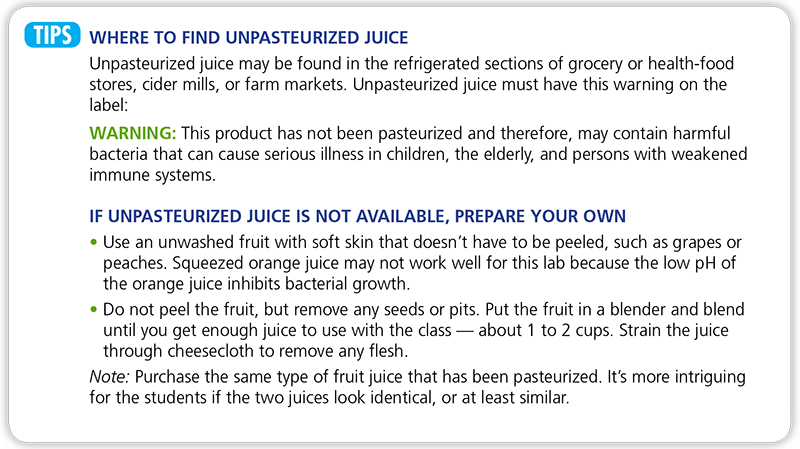Students will discover the importance of pasteurization in relation to food safety. They will understand the importance of reading product labels that indicate whether or not a food has been pasteurized. Food safety plays a major role throughout food processing.
Pasteurization
Pasteurization is the process of using heat or irradiation to destroy microorganisms that could cause disease. Today’s modern dairy farms may house up to 5,000 cows each. All the farm’s milk is pooled, so if one cow is sick, there is a possibility to contaminate all the milk. That’s why milk is pasteurized.
Milk was one of the first products to be pasteurized on a broad scale. In addition to dairy products, other pasteurized foods include fruit juices, chicken, beef, and spices.
One challenge scientists faced was trying to figure out how to pasteurize an egg without cooking it. The solution was to heat the eggs up slowly to 135° F (57° C) and maintain that temperature for 1 hour and 15 minutes. This time/temperature relationship inactivates the bacteria while keeping the eggs fluid.
Louis Pasteur (1822–1895), a chemist, was actually trying to prevent spoilage in wine and beer when he discovered pasteurization. Pasteurization was applied first in wine preservation. When milk producers adopted the process, it reduced foodborne illness substantially. You never know where science will lead you!
Traditional pasteurization is achieved by exposing foods to heat for a certain length of time. Bacteria are very heat-sensitive, and the higher the temperature, the quicker they can be inactivated. Using higher heat takes less time to kill pathogenic bacteria, whereas using lower heat takes more time.
Irradiation
Irradiation is the process in which ionizing energy is used to kill foodborne pathogens. During irradiation, an intense pulse of energy is emitted, either from a gamma radiation source like Cobalt 60 or from an electrical source like an electron beam accelerator. The energy penetrates the food and destroys any bacteria.
Irradiation damages the microbe’s DNA. Unless it can repair the damage, the microbe will die when it grows and tries to duplicate itself.
Ultra High Pressure (UHP) Treatment
UHT is a newer process that some food producers use for killing harmful bacteria in foods that contain water. This process destroys bacteria without the use of high temperatures or chemical additives. Thus, foods such as juices, salsas, cold cuts, and other moist foods are made safer while the vitamins, flavor, and freshness of the foods are maintained.
Using specially designed equipment, the food is subjected to 50,000 to 100,000 pounds of pressure per square inch. This ultra high pressure is maintained from 30 seconds to a few minutes, depending on the food. The ultra high pressure interferes with the metabolism and structure of bacteria and destroys these living cells without altering the basic composition of the food.
Important Note: Despite pasteurization, irradiation, and ultra high pressure (UHP) treatment, food can still become contaminated if the basic rules of food safety are not followed all along the Farm-to-Table Continuum. It’s important to always follow the 4 Cs of Food Safety: Clean, Cook, Chill, and Combat Cross-Contamination (Separate).
Transportation
The 4 Cs of Food Safety play a very prominent role during transportation. Keeping food safe and in good condition as it’s shipped across the country or around the world is critical. There are many steps to shipping food safely and there’s science behind each step.
- The cold chain has to be maintained throughout the loading process, in transit, and during receiving.
- The food is cleaned and precooled as it comes from the field or plant. The cooling extends product life by reducing field heat, rate of ripening, loss of moisture, rate of respiration, and the spread of decay.
- Proper packaging is selected for the product. The shipping container is cleaned and properly loaded, making sure that the boxes are stacked tightly to lock in the cold during transit.
- Proper temperature control can be tracked by satellites. Refrigerated containers usually have equipment that automatically records refrigeration system functions and the air temperature inside the container. This information provides a detailed record of refrigeration system performance throughout the trip.
- Food is properly stored and cooled at the warehouse.
Science and our Food Supply Modules
This lesson was developed as a portion of an entire unit of lessons focusing on food safety from farm to table. Use the following links to see the remaining lessons:
Module 1: Bacteria
Module 2: Farm
Module 3: Processing and Transportation
Module 4: Retail and Home
Module 5: Outbreak and Future Technology
Evaluation
